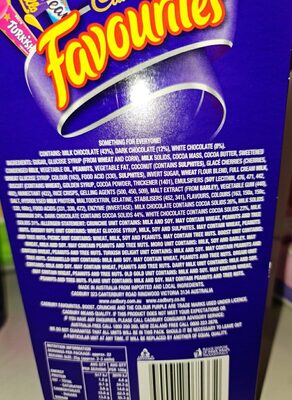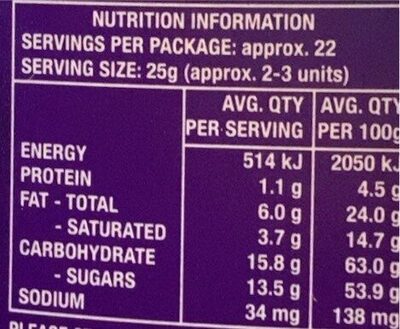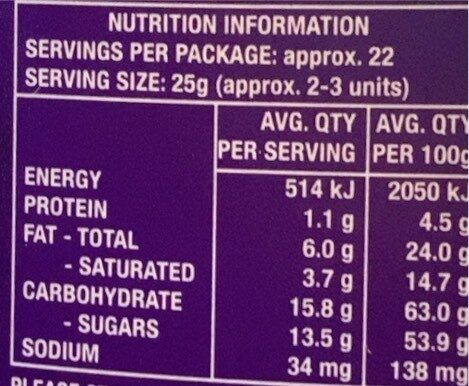Help us make food transparency the norm!
As a non-profit organization, we depend on your donations to continue informing consumers around the world about what they eat.
The food revolution starts with you!
Cadbury Favourites
Cadbury Favourites
This product page is not complete. You can help to complete it by editing it and adding more data from the photos we have, or by taking more photos using the app for Android or iPhone/iPad. Thank you!
×
Barcode: 9300617075332 (EAN / EAN-13)
Brands: Cadbury
Stores: Woolworths, Coles, Kmart, Big-W
Countries where sold: Australia
Matching with your preferences
Health
Ingredients
-
90 ingredients
sugar, glucose syrup (from wheat and corn), milk solids, cocoa mass, cocoa butter, sweetened condensed milk, vegetable oil, peanuts, vegetable fat, coconut (contains sulphites), glacé cherries (cherries, wheat glucose syrup, colour (163), food acid (330), sulphites), invert sugar, wheat flour blend, full cream milk, biscuit (contains wheat), golden syrup, cocoa powder, thickener (1401), emulsifiers (soy lecithin, 476, 471, 442 4, humectant (422), rice crisps, gelling agents (500, 450, 509), malt extract (from barley), vegetable gum (440), salt, hydrolysed milk protein, maltodextrin, gelatine, stabilisers (452, 341), flavours, colours (163, 150a, 150c, t, 16uc), food acids (331, 330, 472), enzyme (invertase), milk chocolate contains cocoa solids 26%, milk suids mm 24%. dark chocolate contains cocoa solids 44%, white chocolate contains cocoa solids 23%, milk us s1%. allergen statement: crunchie unit contains: milk and soy, may contain wheat, peanuts and thee ry kipe unit contains: wheat glucose syrup, milk, soy and sulphites. may contain wheat, peaiuis ois. picic unit contains: wheat, milk, soy and peanuts, may contain tree nuts. boost unit contans k and soy. may contain peanuts and tree nuts, moro unit contains: milk, soy and barley re contain wmeat, peanuts and tree nuts. turkish delight unit contains: milk and soy, may contain peanuts and sree nuts. caramello unit contains: milk and soy, may contain wheat, peanuts and tree nuts. dream unit d soy, may contain wheat, peanuts and tree nuts, dairy milik unit contains: milk and sur may contan wheat, peanuts and tree nuts. old gold unit contains: milk and soy. may contain wneat, peanuts and tree nuts. flake unit contains: milk and soy. may contain peanuts and tree nuts made in australia from imported and local ingredients. milk chocolate (43%), dark chocolate (12%), white chocolate (8%).Allergens: Gluten, Milk, Peanuts, Soybeans, Sulphur dioxide and sulphitesTraces: Gluten, Milk, Nuts, Peanuts, Soybeans, Sulphur dioxide and sulphites
Food processing
-
Ultra processed foods
Elements that indicate the product is in the 4 - Ultra processed food and drink products group:
- Additive: E1401 - Acid-treated modified starch
- Additive: E150a - Plain caramel
- Additive: E150c - Ammonia caramel
- Additive: E163 - Anthocyanins
- Additive: E322 - Lecithins
- Additive: E422 - Glycerol
- Additive: E428 - Gelatine
- Additive: E440 - Pectins
- Additive: E450 - Diphosphates
- Additive: E452 - Polyphosphates
- Additive: E471 - Mono- and diglycerides of fatty acids
- Additive: E476 - Polyglycerol polyricinoleate
- Ingredient: Colour
- Ingredient: Emulsifier
- Ingredient: Flavouring
- Ingredient: Gelling agent
- Ingredient: Glucose
- Ingredient: Glucose syrup
- Ingredient: Humectant
- Ingredient: Hydrolysed proteins
- Ingredient: Invert sugar
- Ingredient: Maltodextrin
- Ingredient: Milk proteins
- Ingredient: Thickener
Food products are classified into 4 groups according to their degree of processing:
- Unprocessed or minimally processed foods
- Processed culinary ingredients
- Processed foods
- Ultra processed foods
The determination of the group is based on the category of the product and on the ingredients it contains.
Additives
-
E1103 - Invertase
Invertase: Invertase is an enzyme that catalyzes the hydrolysis -breakdown- of sucrose -table sugar- into fructose and glucose. Alternative names for invertase include EC 3.2.1.26, saccharase, glucosucrase, beta-h-fructosidase, beta-fructosidase, invertin, sucrase, maxinvert L 1000, fructosylinvertase, alkaline invertase, acid invertase, and the systematic name: beta-fructofuranosidase. The resulting mixture of fructose and glucose is called inverted sugar syrup. Related to invertases are sucrases. Invertases and sucrases hydrolyze sucrose to give the same mixture of glucose and fructose. Invertases cleave the O-C-fructose- bond, whereas the sucrases cleave the O-C-glucose- bond.For industrial use, invertase is usually derived from yeast. It is also synthesized by bees, which use it to make honey from nectar. Optimal temperature at which the rate of reaction is at its greatest is 60 °C and an optimum pH of 4.5. Typically, sugar is inverted with sulfuric acid.Source: Wikipedia
-
E163 - Anthocyanins
Anthocyanin: Anthocyanins -also anthocyans; from Greek: ἄνθος -anthos- "flower" and κυάνεος/κυανοῦς kyaneos/kyanous "dark blue"- are water-soluble vacuolar pigments that, depending on their pH, may appear red, purple, or blue. Food plants rich in anthocyanins include the blueberry, raspberry, black rice, and black soybean, among many others that are red, blue, purple, or black. Some of the colors of autumn leaves are derived from anthocyanins.Anthocyanins belong to a parent class of molecules called flavonoids synthesized via the phenylpropanoid pathway. They occur in all tissues of higher plants, including leaves, stems, roots, flowers, and fruits. Anthocyanins are derived from anthocyanidins by adding sugars. They are odorless and moderately astringent. Although approved to color foods and beverages in the European Union, anthocyanins are not approved for use as a food additive because they have not been verified as safe when used as food or supplement ingredients. There is no conclusive evidence anthocyanins have any effect on human biology or diseases.Source: Wikipedia
-
E322 - Lecithins
Lecithins are natural compounds commonly used in the food industry as emulsifiers and stabilizers.
Extracted from sources like soybeans and eggs, lecithins consist of phospholipids that enhance the mixing of oil and water, ensuring smooth textures in various products like chocolates, dressings, and baked goods.
They do not present any known health risks.
-
E322i - Lecithin
Lecithins are natural compounds commonly used in the food industry as emulsifiers and stabilizers.
Extracted from sources like soybeans and eggs, lecithins consist of phospholipids that enhance the mixing of oil and water, ensuring smooth textures in various products like chocolates, dressings, and baked goods.
They do not present any known health risks.
-
E330 - Citric acid
Citric acid is a natural organic acid found in citrus fruits such as lemons, oranges, and limes.
It is widely used in the food industry as a flavor enhancer, acidulant, and preservative due to its tart and refreshing taste.
Citric acid is safe for consumption when used in moderation and is considered a generally recognized as safe (GRAS) food additive by regulatory agencies worldwide.
-
E331 - Sodium citrates
Sodium citrate: Sodium citrate may refer to any of the sodium salts of citrate -though most commonly the third-: Monosodium citrate Disodium citrate Trisodium citrateThe three forms of the salt are collectively known by the E number E331. Sodium citrates are used as acidity regulators in food and drinks, and also as emulsifiers for oils. They enable cheeses to melt without becoming greasy.Source: Wikipedia
-
E341 - Calcium phosphates
Calcium phosphate: Calcium phosphate is a family of materials and minerals containing calcium ions -Ca2+- together with inorganic phosphate anions. Some so-called calcium phosphates contain oxide and hydroxide as well. They are white solids of nutritious value.Source: Wikipedia
-
E422 - Glycerol
Glycerol: Glycerol -; also called glycerine or glycerin; see spelling differences- is a simple polyol compound. It is a colorless, odorless, viscous liquid that is sweet-tasting and non-toxic. The glycerol backbone is found in all lipids known as triglycerides. It is widely used in the food industry as a sweetener and humectant and in pharmaceutical formulations. Glycerol has three hydroxyl groups that are responsible for its solubility in water and its hygroscopic nature.Source: Wikipedia
-
E440 - Pectins
Pectins (E440) are natural carbohydrates, predominantly found in fruits, that act as gelling agents in the food industry, creating the desirable jelly-like texture in jams, jellies, and marmalades.
Pectins stabilize and thicken various food products, such as desserts, confectioneries, and beverages, ensuring a uniform consistency and quality.
Recognized as safe by various health authorities, pectins have been widely used without notable adverse effects when consumed in typical dietary amounts.
-
E450 - Diphosphates
Diphosphates (E450) are food additives often utilized to modify the texture of products, acting as leavening agents in baking and preventing the coagulation of canned food.
These salts can stabilize whipped cream and are also found in powdered products to maintain their flow properties. They are commonly present in baked goods, processed meats, and soft drinks.
Derived from phosphoric acid, they're part of our daily phosphate intake, which often surpasses recommended levels due to the prevalence of phosphates in processed foods and drinks.
Excessive phosphate consumption is linked to health issues, such as impaired kidney function and weakened bone health. Though diphosphates are generally regarded as safe when consumed within established acceptable daily intakes, it's imperative to monitor overall phosphate consumption to maintain optimal health.
-
E471 - Mono- and diglycerides of fatty acids
Mono- and diglycerides of fatty acids (E471), are food additives commonly used as emulsifiers in various processed foods.
These compounds consist of glycerol molecules linked to one or two fatty acid chains, which help stabilize and blend water and oil-based ingredients. E471 enhances the texture and shelf life of products like margarine, baked goods, and ice cream, ensuring a smooth and consistent texture.
It is generally considered safe for consumption within established regulatory limits.
-
E476 - Polyglycerol polyricinoleate
Polyglycerol polyricinoleate: Polyglycerol polyricinoleate -PGPR-, E476, is an emulsifier made from glycerol and fatty acids -usually from castor bean, but also from soybean oil-. In chocolate, compound chocolate and similar coatings, PGPR is mainly used with another substance like lecithin to reduce viscosity. It is used at low levels -below 0.5%-, and works by decreasing the friction between the solid particles -e.g. cacao, sugar, milk- in molten chocolate, reducing the yield stress so that it flows more easily, approaching the behaviour of a Newtonian fluid. It can also be used as an emulsifier in spreads and in salad dressings, or to improve the texture of baked goods. It is made up of a short chain of glycerol molecules connected by ether bonds, with ricinoleic acid side chains connected by ester bonds. PGPR is a yellowish, viscous liquid, and is strongly lipophilic: it is soluble in fats and oils and insoluble in water and ethanol.Source: Wikipedia
-
E500 - Sodium carbonates
Sodium carbonates (E500) are compounds commonly used in food preparation as leavening agents, helping baked goods rise by releasing carbon dioxide when they interact with acids.
Often found in baking soda, they regulate the pH of food, preventing it from becoming too acidic or too alkaline. In the culinary world, sodium carbonates can also enhance the texture and structure of foods, such as noodles, by modifying the gluten network.
Generally recognized as safe, sodium carbonates are non-toxic when consumed in typical amounts found in food.
-
E509 - Calcium chloride
Calcium chloride: Calcium chloride is an inorganic compound, a salt with the chemical formula CaCl2. It is a colorless crystalline solid at room temperature, highly soluble in water. Calcium chloride is commonly encountered as a hydrated solid with generic formula CaCl2-H2O-x, where x = 0, 1, 2, 4, and 6. These compounds are mainly used for de-icing and dust control. Because the anhydrous salt is hygroscopic, it is used as a desiccant.Source: Wikipedia
Ingredients analysis
-
May contain palm oil
Ingredients that may contain palm oil: Vegetable oil, Vegetable fat
-
Non-vegan
Non-vegan ingredients: Milk solids, Sweetened condensed milk, Whole milk, E428, Milk, Milk chocolateSome ingredients could not be recognized.
We need your help!
You can help us recognize more ingredients and better analyze the list of ingredients for this product and others:
- Edit this product page to correct spelling mistakes in the ingredients list, and/or to remove ingredients in other languages and sentences that are not related to the ingredients.
- Add new entries, synonyms or translations to our multilingual lists of ingredients, ingredient processing methods, and labels.
If you would like to help, join the #ingredients channel on our Slack discussion space and/or learn about ingredients analysis on our wiki. Thank you!
-
Non-vegetarian
Non-vegetarian ingredients: E428Some ingredients could not be recognized.
We need your help!
You can help us recognize more ingredients and better analyze the list of ingredients for this product and others:
- Edit this product page to correct spelling mistakes in the ingredients list, and/or to remove ingredients in other languages and sentences that are not related to the ingredients.
- Add new entries, synonyms or translations to our multilingual lists of ingredients, ingredient processing methods, and labels.
If you would like to help, join the #ingredients channel on our Slack discussion space and/or learn about ingredients analysis on our wiki. Thank you!
-
Details of the analysis of the ingredients
We need your help!
Some ingredients could not be recognized.
We need your help!
You can help us recognize more ingredients and better analyze the list of ingredients for this product and others:
- Edit this product page to correct spelling mistakes in the ingredients list, and/or to remove ingredients in other languages and sentences that are not related to the ingredients.
- Add new entries, synonyms or translations to our multilingual lists of ingredients, ingredient processing methods, and labels.
If you would like to help, join the #ingredients channel on our Slack discussion space and/or learn about ingredients analysis on our wiki. Thank you!
: sugar, glucose syrup (from wheat, corn), milk solids, cocoa mass, cocoa butter, sweetened condensed milk, vegetable oil, peanuts, vegetable fat, coconut, glacé cherries (cherries, wheat glucose syrup, colour (163), food acid (330), sulphites), invert sugar, wheat flour blend, full cream milk, biscuit, golden syrup, cocoa powder, thickener (1401), emulsifiers, soy lecithin, 476, 471, 442 4, humectant (422), rice crisps, gelling agents (500, 450, 509), malt extract (from barley), vegetable gum (440), salt, hydrolysed milk protein, maltodextrin, gelatine, stabilisers (452, 341), flavours, colours (163, 150a, 150c, t, 16uc), food acids (331, 330, 472), enzyme (invertase), milk chocolate contains cocoa solids 26%, milk suids mm 24%, dark chocolate contains cocoa solids 44%, white chocolate contains cocoa solids 23%, milk us s, glucose syrup, milk, soy, sulphites, peaiuis ois, boost unit contans k and soy, re contain wmeat, peanuts, tree nuts, sree nuts, dream unit d soy, sur may contan wheat, peanuts, tree nuts, may contain wneat, peanuts, tree nuts, from imported and local ingredients, milk chocolate 43%, dark chocolate 12%, white chocolate 8%- sugar -> en:sugar - vegan: yes - vegetarian: yes - ciqual_proxy_food_code: 31016
- glucose syrup -> en:glucose-syrup - vegan: yes - vegetarian: yes - ciqual_proxy_food_code: 31016
- from wheat -> en:wheat - vegan: yes - vegetarian: yes - ciqual_proxy_food_code: 9410
- corn -> en:corn - vegan: yes - vegetarian: yes - ciqual_food_code: 9200
- milk solids -> en:milk-solids - vegan: no - vegetarian: yes - ciqual_proxy_food_code: 19051
- cocoa mass -> en:cocoa-paste - vegan: yes - vegetarian: yes - ciqual_proxy_food_code: 16030
- cocoa butter -> en:cocoa-butter - vegan: yes - vegetarian: yes - ciqual_food_code: 16030
- sweetened condensed milk -> en:sweetened-condensed-milk - vegan: no - vegetarian: yes - ciqual_proxy_food_code: 19051
- vegetable oil -> en:vegetable-oil - vegan: yes - vegetarian: yes - from_palm_oil: maybe
- peanuts -> en:peanut - vegan: yes - vegetarian: yes - ciqual_food_code: 15001
- vegetable fat -> en:vegetable-fat - vegan: yes - vegetarian: yes - from_palm_oil: maybe
- coconut -> en:coconut - vegan: yes - vegetarian: yes - ciqual_proxy_food_code: 15006
- glacé cherries -> en:glace-cherry - vegan: yes - vegetarian: yes - ciqual_food_code: 13008
- cherries -> en:cherry - vegan: yes - vegetarian: yes - ciqual_food_code: 13008
- wheat glucose syrup -> en:wheat-glucose-syrup - vegan: yes - vegetarian: yes - ciqual_proxy_food_code: 31016
- colour -> en:colour
- 163 -> en:163
- food acid -> en:food-acid
- 330 -> en:330
- sulphites -> en:sulfite
- invert sugar -> en:invert-sugar
- wheat flour blend -> en:wheat-flour-blend
- full cream milk -> en:whole-milk - vegan: no - vegetarian: yes - ciqual_food_code: 19023
- biscuit -> en:biscuit - ciqual_food_code: 24000
- golden syrup -> en:golden-syrup - vegan: yes - vegetarian: yes
- cocoa powder -> en:cocoa-powder - vegan: yes - vegetarian: yes - ciqual_food_code: 18100
- thickener -> en:thickener
- 1401 -> en:1401
- emulsifiers -> en:emulsifier
- soy lecithin -> en:soya-lecithin - vegan: yes - vegetarian: yes - ciqual_food_code: 42200
- 476 -> en:476
- 471 -> en:471
- 442 4 -> en:442-4
- humectant -> en:humectant
- 422 -> en:422
- rice crisps -> en:puffed-rice - vegan: yes - vegetarian: yes - ciqual_proxy_food_code: 9100
- gelling agents -> en:gelling-agent
- 500 -> en:500
- 450 -> en:450
- 509 -> en:509
- malt extract -> en:malt-extract - vegan: yes - vegetarian: yes
- from barley -> en:barley - vegan: yes - vegetarian: yes
- vegetable gum -> en:vegetable-gum
- 440 -> en:440
- salt -> en:salt - vegan: yes - vegetarian: yes - ciqual_food_code: 11058
- hydrolysed milk protein -> en:hydrolysed-milk-protein - vegan: maybe - vegetarian: yes
- maltodextrin -> en:maltodextrin - vegan: yes - vegetarian: yes
- gelatine -> en:e428 - vegan: no - vegetarian: no
- stabilisers -> en:stabiliser
- 452 -> en:452
- 341 -> en:341
- flavours -> en:flavouring - vegan: maybe - vegetarian: maybe
- colours -> en:colour
- 163 -> en:163
- 150a -> en:150a
- 150c -> en:150c
- t -> en:t
- 16uc -> en:16uc
- food acids -> en:food-acids
- 331 -> en:331
- 330 -> en:330
- 472 -> en:472
- enzyme -> en:enzyme - vegan: maybe - vegetarian: maybe
- invertase -> en:e1103 - vegan: yes - vegetarian: yes
- milk chocolate contains cocoa solids -> en:milk-chocolate-contains-cocoa-solids - percent: 26
- milk suids mm -> en:milk-suids-mm - percent: 24
- dark chocolate contains cocoa solids -> en:dark-chocolate-contains-cocoa-solids - percent: 44
- white chocolate contains cocoa solids -> en:white-chocolate-contains-cocoa-solids - percent: 23
- milk us s -> en:milk-us-s
- glucose syrup -> en:glucose-syrup - vegan: yes - vegetarian: yes - ciqual_proxy_food_code: 31016
- milk -> en:milk - vegan: no - vegetarian: yes - ciqual_proxy_food_code: 19051
- soy -> en:soya - vegan: yes - vegetarian: yes
- sulphites -> en:sulfite
- peaiuis ois -> en:peaiuis-ois
- boost unit contans k and soy -> en:boost-unit-contans-k-and-soy
- re contain wmeat -> en:re-contain-wmeat
- peanuts -> en:peanut - vegan: yes - vegetarian: yes - ciqual_food_code: 15001
- tree nuts -> en:tree-nut - vegan: yes - vegetarian: yes
- sree nuts -> en:sree-nuts
- dream unit d soy -> en:dream-unit-d-soy
- sur may contan wheat -> en:sur-may-contan-wheat
- peanuts -> en:peanut - vegan: yes - vegetarian: yes - ciqual_food_code: 15001
- tree nuts -> en:tree-nut - vegan: yes - vegetarian: yes
- may contain wneat -> en:may-contain-wneat
- peanuts -> en:peanut - vegan: yes - vegetarian: yes - ciqual_food_code: 15001
- tree nuts -> en:tree-nut - vegan: yes - vegetarian: yes
- from imported and local ingredients -> en:from-imported-and-local-ingredients
- milk chocolate -> en:milk-chocolate - vegan: no - vegetarian: yes - ciqual_food_code: 31004 - percent: 43
- dark chocolate -> en:dark-chocolate - vegan: maybe - vegetarian: yes - ciqual_proxy_food_code: 31074 - percent: 12
- white chocolate -> en:white-chocolate - vegan: maybe - vegetarian: yes - ciqual_food_code: 31010 - percent: 8
Nutrition
-
Missing data to compute the Nutri-Score
Missing category
⚠ ️The category of the product must be specified in order to compute the Nutri-Score.Could you add the information needed to compute the Nutri-Score? Add a category
-
Nutrition facts
Nutrition facts As sold
for 100 g / 100 mlEnergy 2,055 kj
(491 kcal)Fat 24 g Saturated fat 14.8 g Carbohydrates 63.2 g Sugars 54 g Fiber ? Proteins 4.4 g Salt 0.34 g Fruits‚ vegetables‚ nuts and rapeseed‚ walnut and olive oils (estimate from ingredients list analysis) 0.537 %
Environment
-
Eco-Score not computed - Unknown environmental impact
We could not compute the Eco-Score of this product as it is missing some data, could you help complete it?Could you add a precise product category so that we can compute the Eco-Score? Add a category
Packaging
-
Missing packaging information for this product
⚠ ️ The information about the packaging of this product is not filled in.Take a photo of the recycling information Take a photo of the recycling information
Transportation
-
Origins of ingredients
Origins of ingredients with a high impact
Origin of the product and/or its ingredients % of ingredients Impact Unknown 100 %High Australia 0 %Medium
Report a problem
-
Incomplete or incorrect information?
Category, labels, ingredients, allergens, nutritional information, photos etc.
If the information does not match the information on the packaging, please complete or correct it. Open Food Facts is a collaborative database, and every contribution is useful for all.
Data sources
Product added on by inf
Last edit of product page on by foodless.
Product page also edited by archanox, carlafelton, charlesnepote, ecoscore-impact-estimator, kiliweb, openfoodfacts-contributors, roboto-app, wriya, yuka.sY2b0xO6T85zoF3NwEKvlkN3c9XCrx_jOzrml2GS1uiBD7CxavR33qLeOKs.








